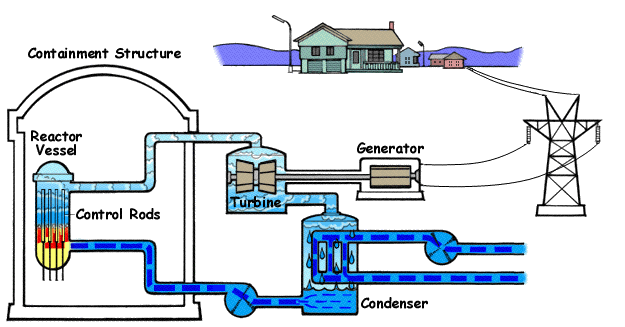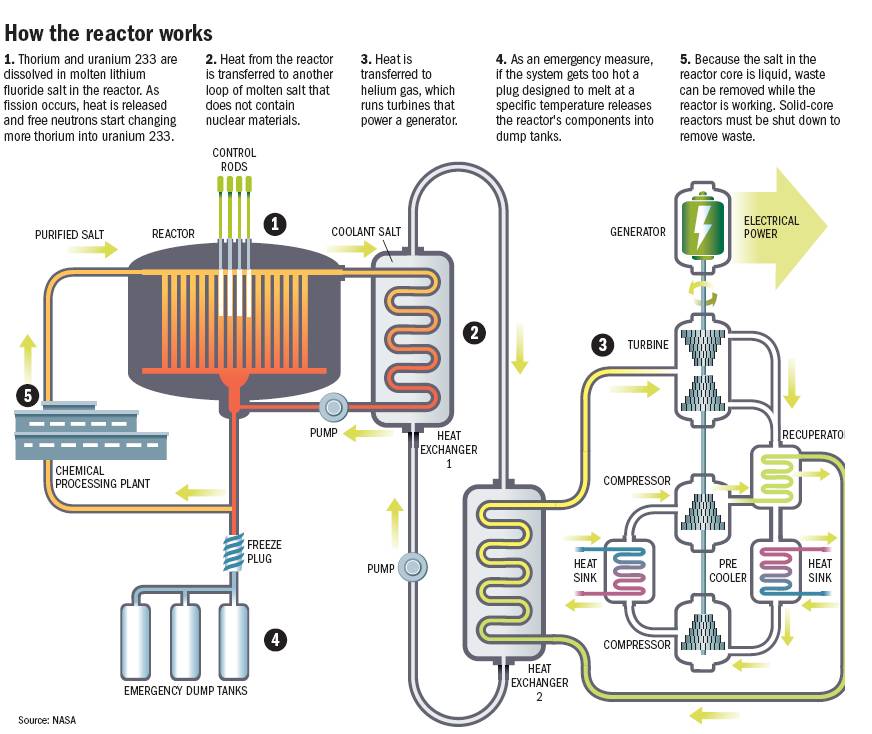Lately, it's a topic I've been very interested in, more so than in the past. that is to say, Nuclear power. There is a LOT of misinformation, and FUD, surrounding nuclear power. People like to point to 3 mile island, and of course, Chernobyl when speaking out against it. That got me to thinking, and I've spent a lot of time, doing research, documentaries, and reading a lot of literature on it. I'm not a nuclear engineer, at all But Something I do have is a talent to read, and look at something and be able to very quickly and easily grok it. that is to say, inherently understand. I can look at something, and understand how it works.
And what I've found is... People have no idea what they are afraid of. They hear nuclear and think that what happened at chernobyl could happen anywhere. For those who don't know, this is what really caused the disaster at Chernobyl.
The soviet RBMK1000 reactors, like those used at Chernobyl, were actually quite impressive in many ways. They were cheap to build, and easy to operate compared to most other reactors at the time. However, it had some major flaws, that, coupled with operators who weren't aware of those flaws because it was kept hidden, meant that the disaster was inevitable.
Prior to the accident, the operators of the Chernobyl NPP were planning to run a test on the Unit #4 to see how long the turbines would continue to generate power to power the reactors main coolant pumps, before the diesel generators kicked in. For the test, they wanted the reactor to be in a certain power range. As they decreased power by inserting the control rods, a side effect of the design of the reactor meant that with lower power, a certain element was produced that "poisoned" the core, further lowering output.
After a time, the reactor reached a dangerously low ~30MW output, practically in a shutdown state. In order to compensate for this, and try to bring it back up to the roughly 700MW they needed for the test, and to combat the core poisoning, they fully retracted almost all of the 200+ control rods. The design of the reactor was unique, it used graphite as a neutron modulator, along with light water, to keep the reaction under control. This is similar to a Boiling water reactor in terms of operation, but the steam doesn't all go through the generator, some steam and water that go through the steam seperator go back through the main coolant pumps and into the reactor.
The temperature of the coolant inlet greaty affected the power output of the reactor. So at the time the test began, the reactor was very unstable, the control rods fully retracted, the reaction being kept under control by the cooler water, as the steam/heat was being used to drive the turbines.
When they began the test and shut down the turbine, heat was no longer being dissapated by the turbines, and the coolant inlet temperature of the reactor increased dramatically, which in turn increased the reactivity. As this happened, the water in the core started to boil, generating steam bubbles, or "voids"
This is where the design started to get, for lack of a better term, dangerous. The RBMK reactors had a very, very high positive void coefficient. Compare that to pretty much all reactors elsewhere, including our own here in the states. What that means is, as bubbles, or "Voids" are created, the rate of reaction increases, versus in a negative void coefficient reactor, which means that voids DECREASE the reaction. So as the water boiled, the reaction increased, increasing steam generation, a positive feedback loop.
The power output of the reactor increased to ridiculous levels, and the unit operators SCRAMed the reactor, inserting the control rods. This is where the other major flaw of the RBMK reactors lay. The control rods had graphite tips, which cleared water out of the channels as they were inserted. This had the unintended effect of actually increasing the reaction rate in the bottom of the core, which was what caused the initial steam explosion inside the core.
That explosion damaged and cracked the control rods, preventing them from fully inserting, only being inserted partway at the time. The reaction continued to increase as the water boiled away. The pressure inside the vessel grew and grew, until the 1000ton pressure vessel head literally blew off, damaging the building, and exposing the reactor core to the outside. In the explosion, tons of highly radioactive fuel and graphite moderator were scattered, and caught on fire, sending radiation into the atmosphere.
If they had figured out what happened sooner, and had evacuated sooner, it wouldn't have been so bad. But the dosimeters/geiger coutners they had at the time only measued up to 3.6mRoentegens/hr. So they decided that was as high as it was and chose not to inform the public about it. It wasn't until later, after firement and others had died from the radiation trying to put out the fire, that they found out that the radiation levels were actually over 10,000Roentegens/hr.
And thus you have the Chernobyl disaster. It wouldn't have been nearly so bad if the reactor operators had known about the flaws, but they were told that it was perfect and there couldn't be any design flaws. The RBMK1000 was perfect, as far as they knew.
What happened at chernobyl could not happen with our reactors. The designs are very different.
PWR (Pressurized Water Reactor. Most common design these days, and the ones used in Naval Reactors)

Traditional Boiling Water Reactor (BWR) used in a lot of power plants as they are simpler and less expensive than a PWR, but still doesn't have the drawbacks of neutron moderator, and higher positive void coefficient of the RBMK.

Soviet RBMK1000 (Chernobyl Type)

This is what a current RBMK (the remaining units were modified, and there are some still operating today) The giant "circle" in the floor is the top of the reactor containment vessel. It contains the control rods, and gave the reactor the ability to be refueled during operation by pulling the fuel rods out of the top of the channels. That is what was blown off by the steam explosion.

Thorium Reactor

And what I've found is... People have no idea what they are afraid of. They hear nuclear and think that what happened at chernobyl could happen anywhere. For those who don't know, this is what really caused the disaster at Chernobyl.
The soviet RBMK1000 reactors, like those used at Chernobyl, were actually quite impressive in many ways. They were cheap to build, and easy to operate compared to most other reactors at the time. However, it had some major flaws, that, coupled with operators who weren't aware of those flaws because it was kept hidden, meant that the disaster was inevitable.
Prior to the accident, the operators of the Chernobyl NPP were planning to run a test on the Unit #4 to see how long the turbines would continue to generate power to power the reactors main coolant pumps, before the diesel generators kicked in. For the test, they wanted the reactor to be in a certain power range. As they decreased power by inserting the control rods, a side effect of the design of the reactor meant that with lower power, a certain element was produced that "poisoned" the core, further lowering output.
After a time, the reactor reached a dangerously low ~30MW output, practically in a shutdown state. In order to compensate for this, and try to bring it back up to the roughly 700MW they needed for the test, and to combat the core poisoning, they fully retracted almost all of the 200+ control rods. The design of the reactor was unique, it used graphite as a neutron modulator, along with light water, to keep the reaction under control. This is similar to a Boiling water reactor in terms of operation, but the steam doesn't all go through the generator, some steam and water that go through the steam seperator go back through the main coolant pumps and into the reactor.
The temperature of the coolant inlet greaty affected the power output of the reactor. So at the time the test began, the reactor was very unstable, the control rods fully retracted, the reaction being kept under control by the cooler water, as the steam/heat was being used to drive the turbines.
When they began the test and shut down the turbine, heat was no longer being dissapated by the turbines, and the coolant inlet temperature of the reactor increased dramatically, which in turn increased the reactivity. As this happened, the water in the core started to boil, generating steam bubbles, or "voids"
This is where the design started to get, for lack of a better term, dangerous. The RBMK reactors had a very, very high positive void coefficient. Compare that to pretty much all reactors elsewhere, including our own here in the states. What that means is, as bubbles, or "Voids" are created, the rate of reaction increases, versus in a negative void coefficient reactor, which means that voids DECREASE the reaction. So as the water boiled, the reaction increased, increasing steam generation, a positive feedback loop.
The power output of the reactor increased to ridiculous levels, and the unit operators SCRAMed the reactor, inserting the control rods. This is where the other major flaw of the RBMK reactors lay. The control rods had graphite tips, which cleared water out of the channels as they were inserted. This had the unintended effect of actually increasing the reaction rate in the bottom of the core, which was what caused the initial steam explosion inside the core.
That explosion damaged and cracked the control rods, preventing them from fully inserting, only being inserted partway at the time. The reaction continued to increase as the water boiled away. The pressure inside the vessel grew and grew, until the 1000ton pressure vessel head literally blew off, damaging the building, and exposing the reactor core to the outside. In the explosion, tons of highly radioactive fuel and graphite moderator were scattered, and caught on fire, sending radiation into the atmosphere.
If they had figured out what happened sooner, and had evacuated sooner, it wouldn't have been so bad. But the dosimeters/geiger coutners they had at the time only measued up to 3.6mRoentegens/hr. So they decided that was as high as it was and chose not to inform the public about it. It wasn't until later, after firement and others had died from the radiation trying to put out the fire, that they found out that the radiation levels were actually over 10,000Roentegens/hr.
And thus you have the Chernobyl disaster. It wouldn't have been nearly so bad if the reactor operators had known about the flaws, but they were told that it was perfect and there couldn't be any design flaws. The RBMK1000 was perfect, as far as they knew.
What happened at chernobyl could not happen with our reactors. The designs are very different.
PWR (Pressurized Water Reactor. Most common design these days, and the ones used in Naval Reactors)

Traditional Boiling Water Reactor (BWR) used in a lot of power plants as they are simpler and less expensive than a PWR, but still doesn't have the drawbacks of neutron moderator, and higher positive void coefficient of the RBMK.

Soviet RBMK1000 (Chernobyl Type)

This is what a current RBMK (the remaining units were modified, and there are some still operating today) The giant "circle" in the floor is the top of the reactor containment vessel. It contains the control rods, and gave the reactor the ability to be refueled during operation by pulling the fuel rods out of the top of the channels. That is what was blown off by the steam explosion.

Thorium Reactor


